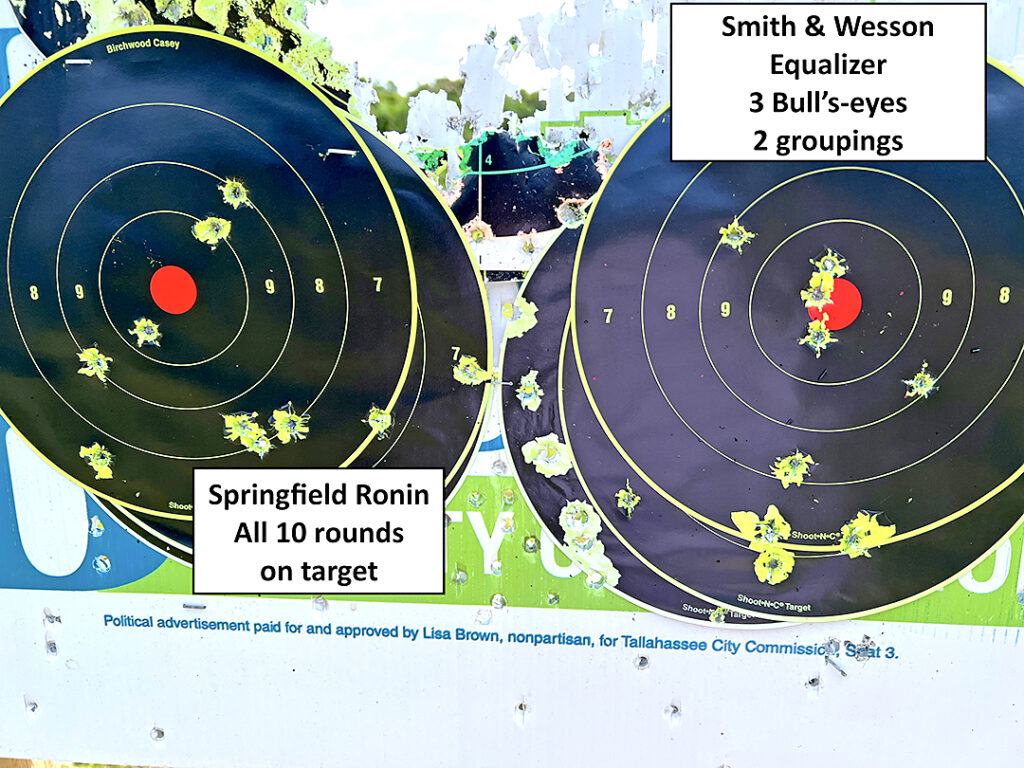Some beginning information on long guns


“What do you plan to shoot today?” asks Joe as we unload the car’s trunk at the Wakulla County Sheriff’s Office range on Wednesday morning at 10 (our usual time to meet weekly with friends and new-to-be friends).
Joe and I have a running challenge. Which is best? A hammer-fired or a striker-fired handgun?
Joe is glued firmly to his Navy roots. He maintains that hammer-fired guns are the very best.
“You can’t beat a 1911’s trigger,” he pontificates smugly. “And there’s the angle of the grip. Hammer guns seat in my hands the best.”
“Yeah, yeah.” Yawn. I’ve heard this statement many times before.
“To answer your question,” I tell him, “today I’m shooting the Springfield Ronin and the Smith & Wesson Equalizer. I know you’ll side with Ronin because it’s a hammer gun. And yes, the barrel is almost three-quarters of an inch longer. And the gun is about a third heavier than the Equalizer.”
“I know you like your Equalizer,” he says, not quite patronizingly, “but Ronin’s longer barrel and heavier weight are going to make a difference. Gasses are trapped and expanding inside the longer barrel, imparting more energy to the bullet, making the gun shoot more accurately.
“Also, the gun’s heavier weight will help to steady your hands and this will be reflected in better shooting. So, both length and weight will make a difference in the accuracy of the Ronin. And,” he adds happily, “when you put Ronin in your hand, its generous beavertail sinks high into your grip.
“Equalizer is a nice enough handgun, but Ronin is a Commander-size 1911.”
“Yes, Ronin is longer and heavier than Equalizer, but I still prefer striker-fired guns. Look, Joe,” I turn the back of the Equalizer to him. “No hammer!”
Joe grins. “Are you sure?”
Since some guns have internal hammers, I lock back the slide and turn over the gun to view the mechanism beneath.
Oops. That slide has been containing a firing pin. Sneaky! Equalizer is a hammer gun after all. Drats.
“OK then,” I concede. “It’s possible that we’ll shoot Ronin more accurately than Equalizer. But I still like my ugly little gun.”
Truly, and not dissing Equalizer, Ronin is sleek and almost pretty: if you can call a gun pretty. Its frame is Cerakoted aluminum, which is part of the reason for the 31-ounce weight. Ronin’s barrel is noticeably thicker than most. Contrasting the barrel and silvery frame are heavily checkered wood grips.
Yep. Pretty.
Ronin has an almost enormous beavertail/grip safety. Yes, the gun does seat comfortably and firmly into your grasp. It feels like an extension of your hand. My little hand or Joe’s big hand: Ronin settles in like it’s meant for each of us.
Ronin has two big white dot sights in the rear and a red fiber optic front sight. Easy to see and to align.
While Ronin appears to be sleek, it measures at 1.18 inches wide. Some of the width has to do with protruding controls on the frame.
Ronin comes with a 9-round magazine.
There you have it. Ronin is a not-quite-compact 1911. Sleek, pretty, heavy-barreled.
Equalizer, on the other hand, is a squatty-looking little micro compact. Well, it’s a micro with 10 rounds until you push in its double-stacked 13 or 15-round magazines.
With the larger magazines, you might not consider it a micro anymore.
But, yes, Equalizer comes with all three magazines. And wait! Wait! There’s more!
Equalizer also comes with a flat or curved trigger and an Uplula, too! We’d give up a lot of Ronin’s pretty for two extra magazines and an UpLula. Do you know how much those things cost?
Let’s look at size.
Equalizer has a 3.675-inch barrel as compared to Ronin’s 4.25-inch one. It has two big white dot rear sights and one big white dot front sight and is just as easy to see as Ronin’s two white rear and one fiber optic front sight.
But, unlike Ronin’s 31-ounce heft, Equalizer weighs in at just 22.9 ounces. This is partly because Equalizer has a polymer frame, not an aluminum one.
It also has no pretty wooden grips. The grips are part of the polymer frame.
Joe and I decide to shoot five rounds with each handgun at the target 7.5 yards away.
We feel the Ronin has a slightly easier trigger pull. At home, later, we measure trigger pull on the Lyman Digital Scale. Sure enough, Ronin’s is 4 pounds, 13 ounces and Equalizer’s is 5 pounds, 10 ounces. Both triggers feel easy and light. The distance they travel is about the same.
Joe feels recoil is lighter on the Ronin, although both guns have light recoils. This one probably feels lighter to him because Ronin’s longer grip allows his big hand a more controlled hold, thus giving a lighter perceived recoil. My smaller hands secure a firmer grip on the Equalizer than on the Ronin, but both guns have comfortable grips.
Both guns have slides that are easy to rack. So, if the Gun Fairy pays you a visit and offers you one of these two guns for free, which one would you take?
Oh, and just to make your choice more difficult, Joe and I both hit the X-ring with the Equalizer.
And for fun, I shot one of my five rounds offhand and scored another bullseye with it.
All 10 rounds show on each target, but we see a couple tight groupings with the Equalizer. These are two targets on a particular Wednesday.
Would results be the same on another day? If we stood on one foot, flapping our elbows, would results be different on another day?
Darn. Gun Fairy, this is a hard decision.
Ronin: Nine rounds, more weight, longer barrel and just plain pretty.
Equalizer: 10, 13 or 15 rounds, an UpLula, less weight, shorter barrel, perhaps more accurate, and, well, sorta ugly.
Gun Fairy, would you give us a few more weeks of practice?
Marj Law is the former director of Keep Wakulla County Beautiful who has become an avid shooter in retirement.


